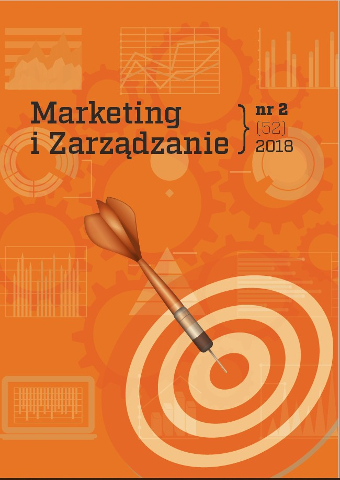
ISSN: 2450-775X
OAI
DOI: 10.18276/miz.2018.52-01


Issue archive /
nr 2 (52) 2018
Selected predictors of the evaluation of credibility of information on food packaging among processors and distributors
| Authors: |
Paweł
Bryła
Uniwersytet Łódzki, Wydział Studiów Międzynarodowych i Politologicznych |
| Keywords: | health-related information food labelling health claims nutritional claims food marketing |
| Data publikacji całości: | 2018 |
| Page range: | 9 (7-15) |
| Klasyfikacja JEL: | Q13 M31 D83 L66 L81 |
Abstract
The article aims to examine the issue of credibility of information placed on food packaging from the perspective of food processors and distributors in Poland. With the use of the CAWI methodology, 78 completed questionnaires were obtained. We used correlations, t-statistics, ANOVAs and simple and multiple regressions. In a multiple regression model, a series of predictors of the credibility were tested. We arrived at a model with 5 statistically significant independent variables. They include: 1) a conviction that the quantity of nutritional claims is appropriate; 2) the understandability of information on the packaging; 3) the share of products with health claims in the offer of the companies under study; 4) self-reported healthiness of one’s nutrition and 5) the tenure of respondents in the examined companies. The perceived credibility increases with an increase in variables 1, 2, and 4 and falls with an increase in variables 3 and 5.
Download file
Article file
Bibliography
| 1. | Anania, G., Nisticò, R. (2004). Public regulation as a substitute for trust in quality food markets: What if the trust substitute cannot be fully trusted? Journal of Institutional and Theoretical Economics, 160 (4), 681‒701. |
| 2. | Atkinson, L., Rosenthal, S. (2014). Signaling the green sell: The influence of eco-label source, argument specificity, and product involvement on consumer trust. Journal of Advertising, 43 (1), 33‒54. |
| 3. | Bryła, P. (2012). Charakterystyka marketingu regionalnych produktów żywnościowych we Francji – wyniki badania. Zeszyty Naukowe Uniwersytetu Szczecińskiego, 709. Problemy Zarządzania, Finansów i Marketingu, 23, 143‒159. |
| 4. | Bryła, P. (2015a). Marketing regionalnych i ekologicznych produktów żywnościowych ‒ perspektywa sprzedawcy i konsumenta. Lodz: Lodz University Press. |
| 5. | Bryła, P. (2015b). The role of appeals to tradition in origin food marketing: a survey among Polish consumers. Appetite, 91, 302‒310. |
| 6. | Bryła, P. (2016). Organic food consumption in Poland: motives and barriers. Appetite, 105, 737‒746. |
| 7. | Bryła, P. (2017). The perception of EU quality signs for origin and organic food products among Polish consumers. Qualityn Assurance and Safety of Crops & Foods, 9 (3), 345‒355. |
| 8. | Chan, C., Patch, C., Williams, P. (2005). Australian consumers are sceptical about but influenced by claims about fat on food labels. European Journal of Clinical Nutrition, 59, 148‒151. |
| 9. | Charlebois, S., Schwab, A., Henn, R., Huck, C. (2016). Food fraud: An exploratory study for measuring consumer perception towards mislabeled food products and influence on self-authentication intentions. Trends in Food Science and Technology, 50, 211‒218. |
| 10. | Derby, B., Levy, A. (2001). Do food labels work? In: Bloom, P., Gundlach, G. (eds.), Handbook of Marketing and Society. Thousand Oaks: Sage. |
| 11. | Garretson, J., Burton, S. (2000). Effects of nutrition facts panel values, nutrition claims, and health claims on consumer attitudes, perceptions of disease-related risks, and trust. Journal of Public Policy & Marketing, 19 (2), 213‒227. |
| 12. | Messer, K., Costaningro, M., Kaiser, H. (2017). Labeling food processes: The good, the bad and the ugly. Applied Economic Perspectives and Policy, 39 (3), 407‒427. |
| 13. | Naylor, R., Droms, C., Haws, K. (2009). Eating with a purpose: Consumer response to functional food health claims in conflicting versus complementary information environments. Journal of Public Policy & Marketing, 28 (2), 221‒233. |
| 14. | Nestorowicz, R. (2014). Aktywność informacyjna konsumentów na rynku żywności prozdrowotnej – wybrane aspekty. Marketing i Rynek, 11 (CD). |
| 15. | Nilsson, H., Tunçer, B., Thidell, Å. (2004). The use of eco-labeling like initiatives on food products to promote quality assurance – is there enough credibility? Journal of Cleaner Production, 12 (5), 517‒526. |
| 16. | Sønderskov, K., Daugbjerg, C. (2011). The state and consumer confidence in eco-labeling: organic labeling in Denmark, Sweden, The United Kingdom and The United States. Agriculture and Human Values, 28 (4), 507‒517. |
| 17. | Staniewska, K., Panfil-Kuncewicz, H., Staniewski, B., Mieczkowska, M. (2010). Postrzeganie informacji żywieniowej przekazywanej za pomocą różnych form przekazów komercyjnych. Zeszyty Naukowe Szkoły Gospodarstwa Wiejskiego w Warszawie. Ekonomika i Organizacja Gospodarki Żywnościowej, 86, 117‒127. |
| 18. | Thorsøe, M., Christensen, T., Povlsen, K. (2016). “Organics’ are good, but we don’t know exactly what the term means!” Trust and knowledge in organic consumption. Food, Culture & Society, 19 (4), 681‒704. |
| 19. | Tonkin, E., Meyer, S., Coveney, J., Webb, T., Wilson, A. (2016). The process of making trust related judgements through interaction with food labelling. Food Policy, 63, 1‒11. |
| 20. | Velčovská, Š., Del Chiappa, G. (2015). The food quality labels: Awareness and willingness to pay in the context of the Czech Republic. Acta Universitatis Agriculturae et Silviculturae Mendelianae Brunensis, 63 (2), 647‒658. |
| 21. | Velčovská, Š., Sadílek, T. (2014). The system of the geographical indication – important component of the politics of the consumers’ protection in European Union. Amfiteatru Economic, 16 (35), 228‒242. |
| 22. | Wills, J., Schmidt, D., Pillo-Blocka, F., Cairns, G. (2009). Exploring global consumer attitudes toward nutrition information on food labels. Nutrition Reviews, 67 (suppl. 1). |
| 23. | Wongprawmas, R., Padilla Bravo, C., Lazo, A., Canavari, M., Spiller, A. (2015). Practitioner’s perceptions of the credibility of food quality assurance schemes: Exploring the effect of country of origin. Quality Assurance and Safety of Crops and Foods, 7 (5), 789‒799. |